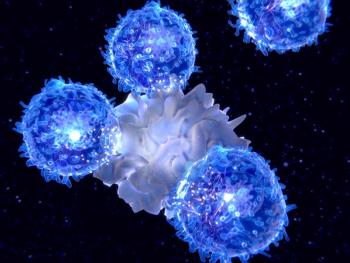
PET-CT Responses After First-Line Immunochemotherapy in FL
Evaluating the prognostic value of PET-CT responses after first-line immunochemotherapy in follicular lymphoma.
Positron-emission tomography (PET) imaging may better assess response after first-line immunochemotherapy than contrast-enhanced CT for patients with follicular lymphoma, according to a secondary analysis of the GALLIUM study.
“PET-response assessment at the end of induction therapy could inform patients and their clinicians of the probability of both progression-free and overall survival,” Judith Trotman, MBChB, of the University of Sydney, Australia, and colleagues wrote in Lancet Oncology. “The data also support the use of PET assessment according to Lugano 2014 response criteria as a platform to study responses-adapted therapeutic approaches in future clinical trials to improve outcomes for patients with follicular lymphoma.”
GALLIUM is an ongoing, open-label, parallel-group randomized trial compared induction therapy with obinutuzumab compared with rituximab combined with chemotherapy followed by maintenance with the same antibody alone. The study achieved its primary endpoint of a reduction in risk for relapse, progression, or death with obinutuzumab compared with rituximab.
In this secondary
After induction therapy was completed, 65.5% of the 595 patients achieved PET complete response according to IHP 2007 criteria and 75.6% achieved complete metabolic response with the Lugano criteria.
The study showed that metabolic response to induction therapy was prognostic for both progression-free (PFS) and overall survival (OS).
With a median of 43.3 months of observation, 2.5-year PFS from end of induction was 87.8% for PET complete responders compared with 72.0% for non-complete responders assessed by IHP 2007 criteria (HR, 0.4; 95% CI, 0.3-0.6; P < .0001). Using these criteria, the 2.5-year OS was 96.9% in complete responders compared with 90.6% in non-complete responders (HR, 0.4; 95% CI, 0.2-0.9; P = .011).
Using the Lugano 2014 criteria, the difference in PFS was greater. The 2.5-year PFS rate was 87.4% for PET complete responders compared with 54.9% in non-complete responders (hazard ratio [HR], 0.2; 95% CI, 0.1–0.3; P < .0001). The 2.5-year OS rate was 96.6% compared with 84.0% for non-complete responders (HR, 0.2; 95% CI, 0.1–0.5; P < .0001).
In a commentary published with the study, Stefano Luminari, of the University of Modena and Reggio Emilia, Italy, wrote that no prognostic tools developed to date for follicular lymphoma have been useful in therapeutic decision making. In Trotman et al, the researchers suggest that FDG-PET is the only diagnostic tool required to assess response in patients with follicular lymphoma, but the clinical significance of FDG-PET may be limited by the very low proportion of non-responding patients, Luminari noted.
“The next generation of clinical trials in follicular lymphoma should be designed to test the efficacy of risk-adapted therapies in which metabolic response is integrated with robust clinical and biological prognostic factors to optimize the efficacy-to-safety ratio of therapy in the individual patient,” he wrote.
Newsletter
Stay up to date on recent advances in the multidisciplinary approach to cancer.


















































































